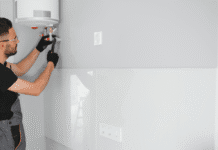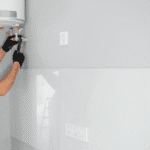Last Updated on January 28, 2024 by Asfa Rasheed
Chevron tiles can lend any space a modern, stylish look with their signature zigzag pattern. However, achieving their striking aesthetic requires precision during installation. This comprehensive DIY guide will walk you through preparing for and executing a flawless chevron tile installation from start to finish.
Table of Contents
Pre-Installation Preparations
Installing chevron tile successfully requires careful planning and preparation. Rushing in without gathering the necessary tools and materials can compromise quality and durability down the road.
Assess Installation Area
First, analyze the floor, wall, or surface area you wish to tile. Take measurements and create a detailed layout diagram indicating problem areas requiring extra prep or tile cuts.
- For floors, check for cracks, uneven surfaces, previous damage, or improper subflooring that must be remediated so flaws do not eventually manifest through the finished tile work.
- For walls, ensure underlying drywall or plaster is properly sealed and primed. Address any moisture issues beforehand.
- Look for potential obstacles like electrical outlets, plumbing fixtures, or ductwork that will require tile cutting.
Once problem areas are addressed, clean thoroughly to remove any dust, oil, or soap residue before tile prep begins.

Gather Equipment and Supplies
These essential tools and materials are necessities for proper chevron tile installation:
Tools
- Tile cutter (wet saw)
- Tile snips
- Tile spacers
- Notched trowel for spreading adhesive
- Grout float for applying grout
- Rubber mallet
- Bucket for mixing grout
- Safety gear: gloves, goggles, knee pads
Materials
- Chevron tiles
- Tile adhesive (thin-set)
- Grout
- Grout sealer
- Levels (standard and laser)
Stock up on extra tile spacers which can be hard to source quickly if initial amounts run short. For specialty cuts, a quality wet saw with adjustable bevel and specialty blades is highly recommended.
Calculate Required Materials
To determine the quantity of tiles needed, carefully measure your installation space. Round up measurements to account for uneven areas and specialty cuts.
Plot out design plans to visualize tile layout. For chevrons, allow for up to 20% overage beyond your base measurements for:
- Damaged tiles that can’t be used
- Imperfect corner, edge, and specialty piece cuts
- Tiles needed to accommodate electrical outlets, vents, or other obstructions
- Shade variations between tile boxes that require blending
Don’t risk running short! Leftover tiles can come in handy for future repairs. For large installations, create a tile schedule broken down by install date to avoid overwhelming problems.
Step-by-Step Installation Instructions
Once planning and prep work is complete, it’s gone time! Use these detailed instructions for flawless chevron tile installation:
Prepare the Installation Surface
Ensure the floor or wall area is clean, dry, and properly primed for tile. Check for level and repair any damaged areas.
Wall Prep
- Seal surfaces with acrylic latex primer
- Install cement backer board if surface is cement, brick, or drywall
Floor Prep
- Confirm subfloor is clean, flat, and stable
- Level any uneven spots with floor leveling compound
- Seal concrete floors with acrylic latex primer
Set Tile Layout
Mark center lines and establish a strong base alignment for the chevron tile pattern to build outward from.
- Snap perpendicular chalk lines marking the center point of the area
- Dry lay tiles at the intersection, aligning directional arrows
- Use a laser level and squares to ensure all sides align to chalk lines
- Dry lay rows moving outwards from the established center to test the layout
Mix and Apply Thinset
Before setting tiles, adhesive “thin-set” mortar must be prepared and spread.
- Pour powdered thin-set mix into the bucket
- Add the correct ratio of clean water per product specifications
- Mix to a smooth, lump-free toothpaste consistency
- Let thin-set slake for 10 minutes before using
- Apply to the wall or floor using notched-edge trowel, combing in straight lines
Set Tiles
Work methodically outward from the centered dry-laid tiles using spacers to set consistent grout line widths.
- Set each tile firmly into position in the directional pattern
- Push downwards to collapse any air pockets and ensure maximum adhesion
- Use level and square often to maintain proper alignment
- Allow thin-set to set according to manufacturer directions before continuing
Avoid the temptation to rush! Allow the thin-set adhesive adequate time to set up between batches of freshly set tiles to prevent shifting.
Cut Perimeter Tiles
Once the field is set, measure and cut border and perimeter pieces. Avoid forcing standard tiles which can compromise the overall layout.
- Mark each line to be cut directly on tiles using a straightedge and pencil
- For specialty edge pieces, cut tiles one-by-one for custom fit
- Use a quality wet saw designed for tile to make straight accurate cuts
- Set custom perimeter pieces completing tile installation
Take time with edge tiles to prevent sloppy misaligned borders from distracting from the overall design.
Grouting Your Newly Set Chevron Tiles
Before enjoying your dazzling chevron design, properly grouting gaps between tiles is an essential final step. When mixed to the right consistency and applied correctly, grout finishes the job.
Grout Selection
Sanded vs Unsanded
Tile joints wider than 1/8” must use sanded grout for durability and crack prevention. For joints under 1/8″, use unsanded. Most chevron tiles require sanded grout.
Grout Color
Choosing whether to accent or blend grout color impacts the overall look. Contrasting grout highlights individual tiles while matching grout unifies the pattern.
Mixing and Applying Grout
Follow all manufacturer specifications for proper water ratios and mixing times.
- Pour grout powder into a bucket
- Add measured clean water amount and mix thoroughly
- Let mixed grout slake 5-10 minutes before applying
- Holding float at 45-degree angle, forcing grout deeply into joints
- Wipe diagonally across tiles with a damp sponge to clean excess
- Buff tiles once grout has cured 24 hours for haze removal
When applying, overfill joints slightly knowing excess will be removed once dried. Using the proper water ratio prevents cracking or loose powdery joints.
Post-Installation Care and Maintenance
Preserving your newly installed chevron tile requires proper ongoing care and routine maintenance.
Daily Cleaning
Regular cleaning keeps soil from accumulating and grout looking fresh.
- Sweep or vacuum floor tiles frequently
- Mix mild pH-neutral cleaner with warm water and apply with a soft cloth
- Rinse thoroughly and buff dry with a microfiber towel
Routine Maintenance
Follow these steps periodically to maintain beauty.
- Reapply penetrating sealant annually to protect grout
- Check for loose or missing tiles around the perimeter and replace
- Tighten any loose underlayment beneath floor tiles
Restorative Deep Cleaning
For occasional heavier soiled areas:
- Mix alkaline tile cleaner concentrate with hot water
- Apply generously and let soak for 5-10 minutes
- Scrub the entire area with a stiff nylon brush
- Rinse thoroughly until water runs clear
By establishing proper care routines, your perfectly installed custom chevron tiles will dazzle for years to come with minimal effort.
FAQs
Plan for 10-20% overage to allow for damaged tiles and specialty cuts needed.
The most common reasons for cracked tiles include inadequate surface prep, improper adhesive or grout selection, and rushing the installation.
Beyond dazzling good looks, the unique zigzag pattern hides subfloor imperfections better since no one tile sits perfectly flush in all directions against the next.
Conclusion
Installing chevron tiles brings stylish drama to any space with the signature zigzag pattern. But while the visual impact delights, executing the precision installation requires careful planning and patience.
By following this start-to-finish guide, DIYers can feel confident tackling even elaborate chevron tile designs. Taking the time to correctly measure the space, calculate required materials, prep the surface, establish the layout, mix thin-set and grout properly, cut specialty border tiles, and apply best practices for care will lead to success.
While chevron installation presents more considerations than basic square tile, the dazzling geometric results are well worth the effort. Just be sure to work methodically, check alignments often, and avoid rushing for quality results.
With the right tools, techniques, and time invested, you can install striking, durable chevron tiles that will elevate your home for years to come. Use this guide as your roadmap to custom chevron tilework you’ll love showing off.
Read More: How to Clean Your Bathroom Tiles
















